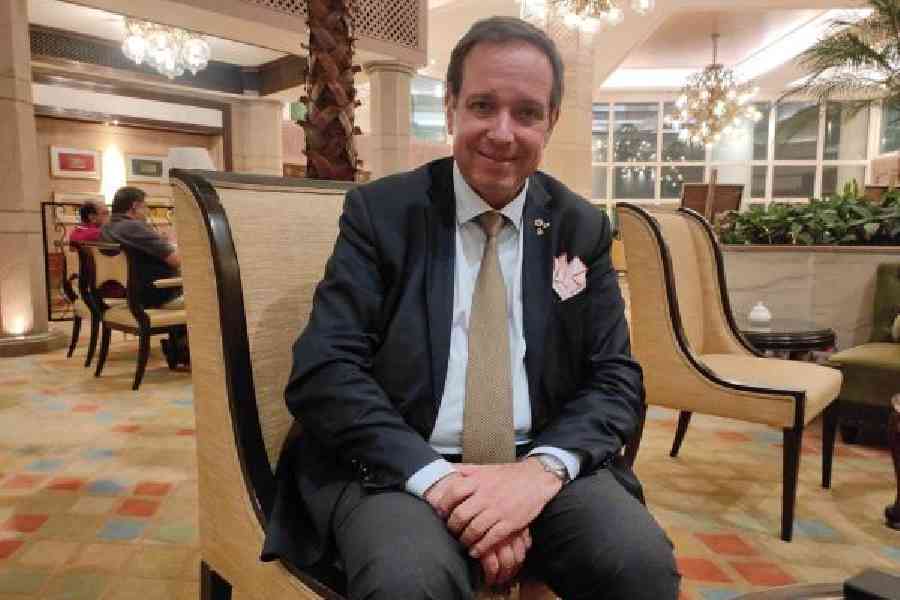The beer and accompanying free cocktail sausages made Firpo’s most endearing to those who can still recall their time at one of the most hip and happening places in this part of the world in the early 40s and 50s.
Among them was 91-year-old M.M. Chatrath, a chartered accountant who spent his Friday evenings at the Chowringhee address. His and others’ reminiscences on an early November Friday evening in 2024 brought alive the Italian restaurant that was established and run by a man from Alessandria in Italy, Angelo Firpo, from 1918-1977.
The occasion was a visit by Firpo’s great- nephew Enrico De Barbieri to the city.
Barbieri is the Angelo Firpo’s brother’s grandson. Organised by the consul general of Italy in Calcutta, Riccardo Dalla Costa, Barbieri is in the city to participate in the ongoing Italian Cuisine Week, which is celebrating the Cuisine of the Roots.
“Italians who migrated to places like Mexico or the US were essentially simple folk, mainly farmers and their cuisine was also simple. But Italians like Firpo or Peliti, who came to Calcutta, were essentially businessmen who brought the continental (French) cuisine to the city,” said Daniele Panfilo from the consulate general of Italy in Calcutta.
The Calcutta chapter of Intach also felicitated Barbieri with a culinary heritage plaque at the Glenburn Penthouse.
“This is my first visit to Calcutta but I have been hearing stories of the city since I was a child. And coming here is like coming home. There are memories of Calcutta and Firpo’s and these memories need to be kept alive,” he said.
Waiters in white gloves, patrons in white coats and black bow ties, table d’hôte four-course menus, live bands playing Hello Dolly, the Lido Room, and red and blue chocolate boxes were some of the things that popped up in conversations about Firpo’s.
Pranab Nath Tagore along with his wife Chitralekha of the Tagore family often dined at Firpo’s, said their granddaughter Nayana Gangooly.
Pranab Nath had forgotten his dentures back home one day and had sent his driver to fetch them. When the dentures arrived, waiters at Firpo’s served them to him on a monogrammed plate, she said.
Culture and art patron Lady Ranoo and industrialist Sir Biren Mookerjee, too, were regulars at Firpo’s.
Social environmentalist Bonani Kakkar remembers erstwhile Tollygunge Club manager Bob Wright narrating that in “those days rickshaws were pulled on Chowringhee Road and that a race would be organised among rickshaw-pullers where they had to pull up the rickshaws over Firpo’s staircase”.
Angela Firpo, who landed at the Calcutta port via London from Italy in 1917, first started his work at another illustrious Italian restaurant, the Peliti’s in Chowringhee.
Later, Firpo bought a spacious place at 11 Government Place East, not far from Peliti’s, and set up his own business. He also took over Peliti’s later. The restaurant started as a tea room specialising in cakes, pastries and confections.
Over time, it transformed into a complete family dining establishment, catering to the European gentry and American GI soldiers.
“Firpo’s popularised continental cuisine in Calcutta,” said G.M. Kapur of Intach.
And such was the business acumen of Firpo, Kapur said, that “he used to then offer home delivery. One just had to call up Firpo’s and place an order and the food would be delivered at home.”
By the mid-1930s, Firpo’s reputation peaked, offering five-course meals in elegant rooms with colourful decor. Its open-air café on a lengthy verandah provided panoramic views of Chowringhee Road and the Maidan.
It is said that Viceroy and Governor-General Lord Irwin held his council meetings at Firpo’s over lunch, theMaharaja of Cooch Behar,the Rana of Nepal, and Soviet supremo Nikita Kruschev were the other clients ofFirpo’s.
Filmmaker Satyajit Ray chose to shoot one of his Calcutta triologies, Seemabaddha, at Firpo’s with dancer Shefali at the Lido Room. Shefali did several gigs at the Lido Room before moving on to the Oberoi Grand.
In 1938, a civic reception for Netaji Subhas Chandra Bose after he was elected Congress president at the Haripura session was also held at Firpo’s, such was the stature of the place.
The reception was organised by Abul Kalam Mohammed Zakaria, the then mayor of Calcutta who had invited the intellectuals and celebrities from the city for a tea party.
The official records of the Kolkata Municipal Corporation from August 13, 1938, document this event.
Barbieri has done the rounds of what used to be Peliti’s and Firpo’s in the city. He has also been to St John’s Church and will visit the Royal Calcutta Golf Club (RCGC) where Firpo’s apparently did the catering.
Back in Genoa where he lives, he has registered the Firpo’s brand name and produces products like pesto, wines, cakes, and pasta.
“I wish to create a new club called Firpo’s Club 1917 in Genoa that will be dedicated to Firpo,” said the bearer of the Firpo’s legacy.










